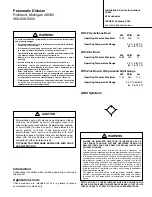
-26-
No. TQ1230001-OM104-A
■
Piping
Caution
1) Preparation before piping
Before piping, perform air blow (flushing) or cleaning to remove any cutting chips, cutting oil, dust, etc. from
the piping.
2) Installation of tubing
・
Cut the tubing perpendicularly, being careful not to damage the outside surface. Use an SMC tube cutter TK-
1,2,3. Do not cut the tubing with pliers, nippers, scissors, etc., otherwise the tubing will be deformed and
problems may result.
・
Grasp the tubing, and slowly push it straight (0 to 5°) into the one-touch fitting until it comes to a stop.
・
Pull the tubing back gently to make sure it has a positive seal. Insufficient installation may cause air to leak
or the tubing to release.
3) Removal of tubing
・
Push the release button flange evenly and sufficiently to release the tube. Do not push in the tubing before
pressing the release button.
・
Pull out the tubing while keeping the release button depressed. If the release button is not held down
sufficiently, the tubing cannot be withdrawn.
・
To release the tubing, remove the previously lodged portion of the tubing. If the lodged portion is left on
without being removed, it may result in air leakage and make the removal of the tubing difficult.
4) When using tubing from a manufacturer other than SMC, be careful of the tolerance of the tubing O.D.
and tubing material.
・
Nylon tubing
Within ±0.1mm
・
Soft nylon tubing
Within ±0.1mm
・
Polyurethane tubing
0.15mm, Within -0.2mm
Do not use tubing which does not satisfy the specified tubing O.D. accuracy. It may cause difficulty in
connecting the tubing, leakage, disconnection of the tubing, or fitting damage.
5) Do not apply unnecessary forces, such as twisting, pulling moment loads, vibration, impact, etc., on
fittings or tubing.
6) Tubing, with the exception of coiled tubing, requires stationary installation. Do not use standard tubing
(non-coiled) din applications where tubing is required to travel inside the flexible protection tube.
Tubing that travels may sustain abrasion, extension, or severance due to tensile force. The removal of
tubing from the fitting may also occur. Use caution prior to use in an application.
・
Do not lift up the product by holding the tubing after piping.
It causes malfunction of one-touch fitting.
Refer to Fittings & Tubing Precautions from 1 to 4 shown in Best Pneumatics 6 on SMC’s website (URL
) for the recommended piping conditions.
7) Adjust the length of air tube following by the movement of the robot arm to avoid adding tension the
tube.
When adding the tension of tube repeatedly, it may result in air leakage.
And the tube bending radius in the vicinity of the fitting should be at least the minimum bending radius of the
tubing.
■
Exhaust from Ejector
If the operating environment contains a lot of particles or mist, the silencer may be clogged. If the silencer is
clogged, it will cause a reduction in the ejector performance. Replace the silencer in
such case. (Refer to “7.1.
Maintenance for vacuum gripper unit”)
■
Exhaust noise
When vacuum ejector generates vacuum, noise can be heard from the exhaust port when the standard supply
pressure is close to the pressure that generates peak vacuum pressure making vacuum pressure unstable. If the
vacuum pressure range is adequate for gripping, there should not be a problem. If the noise causes a problem or
affects the setting of the pressure switch, change the supply pressure slightly to avoid the pressure range of the
noise.





































